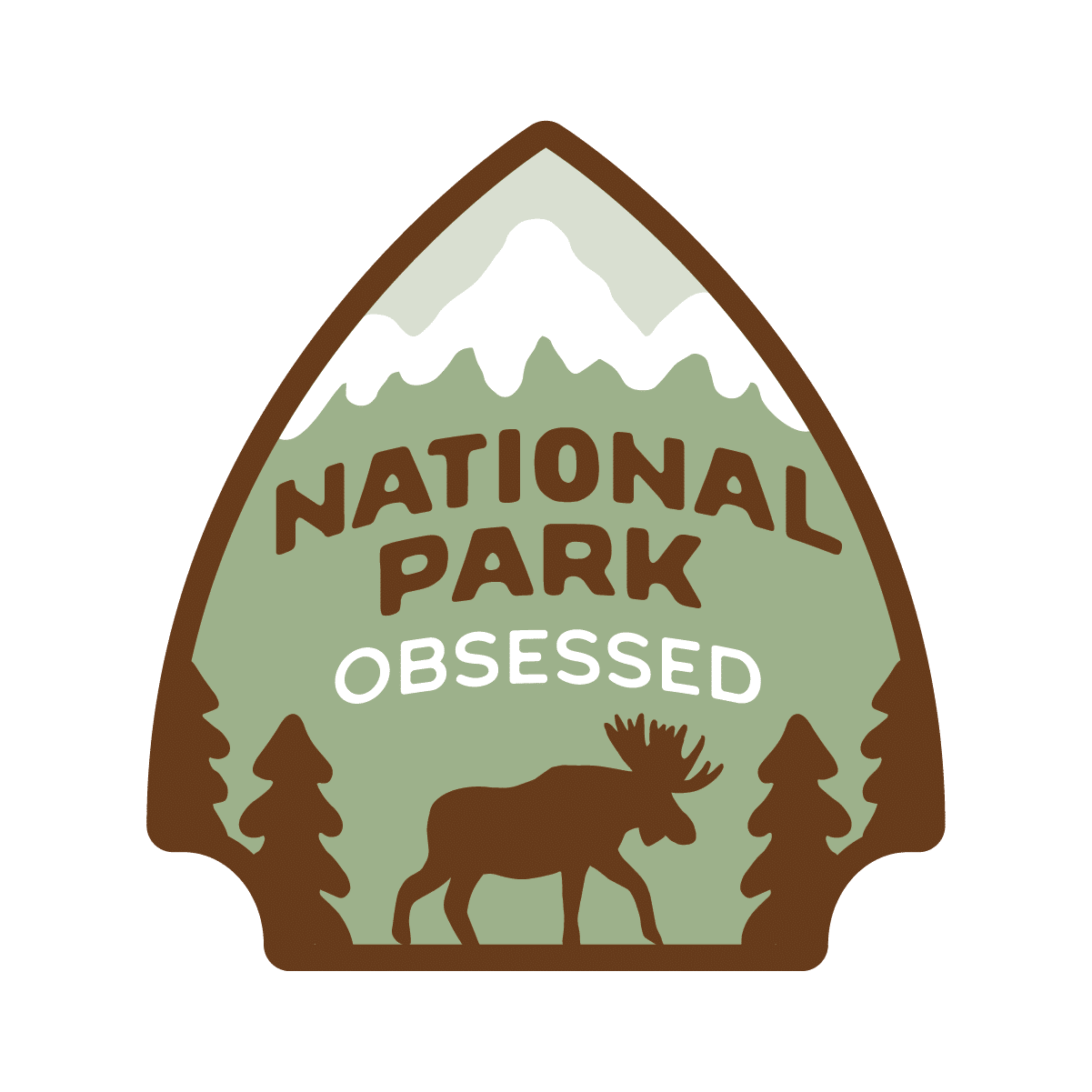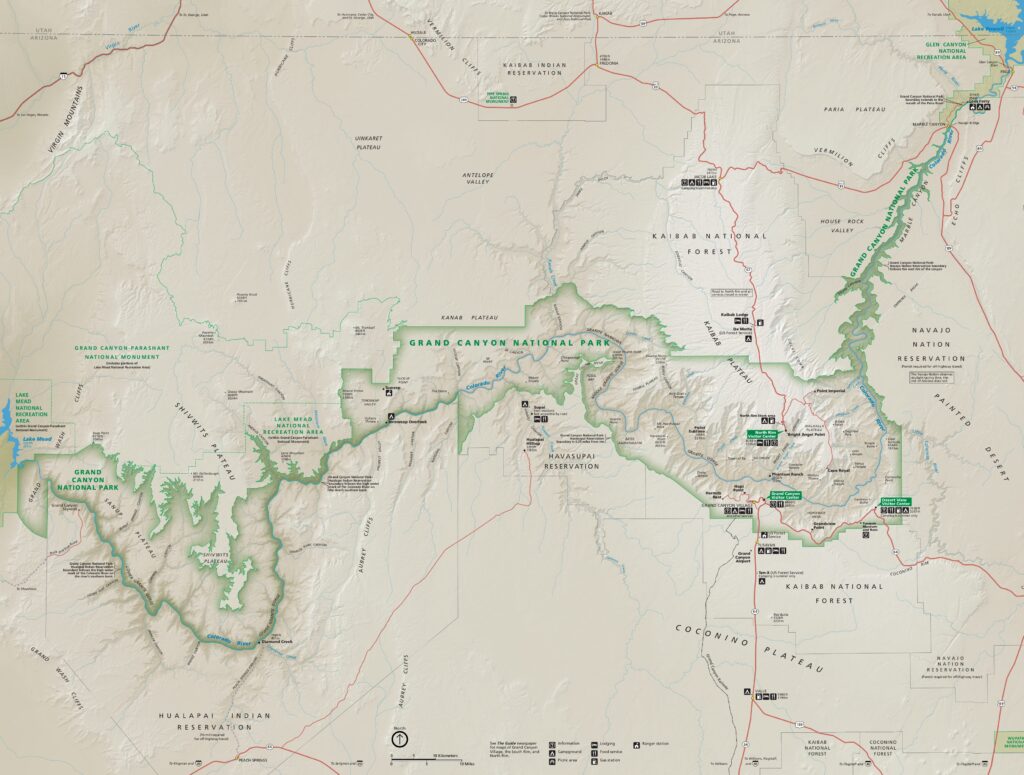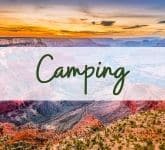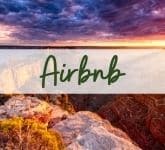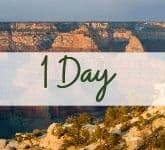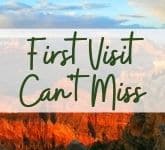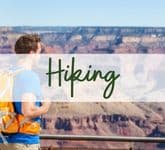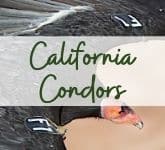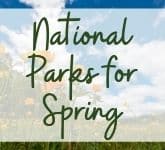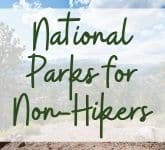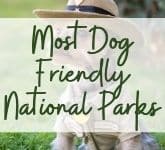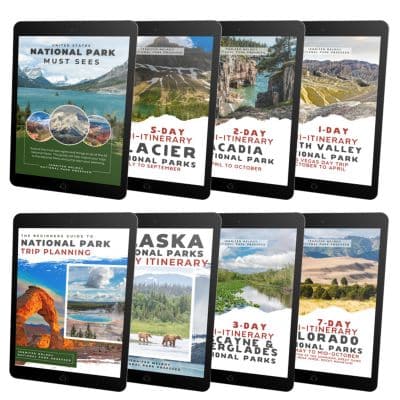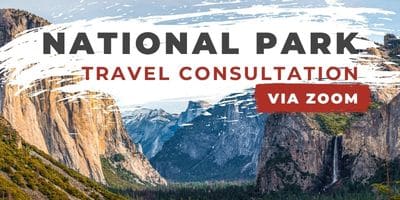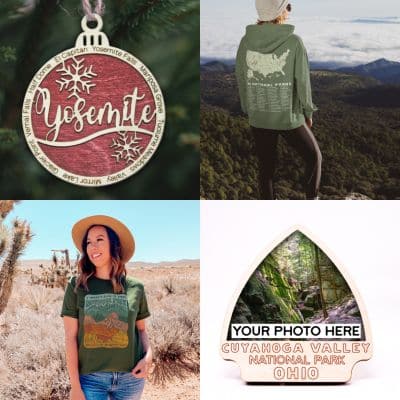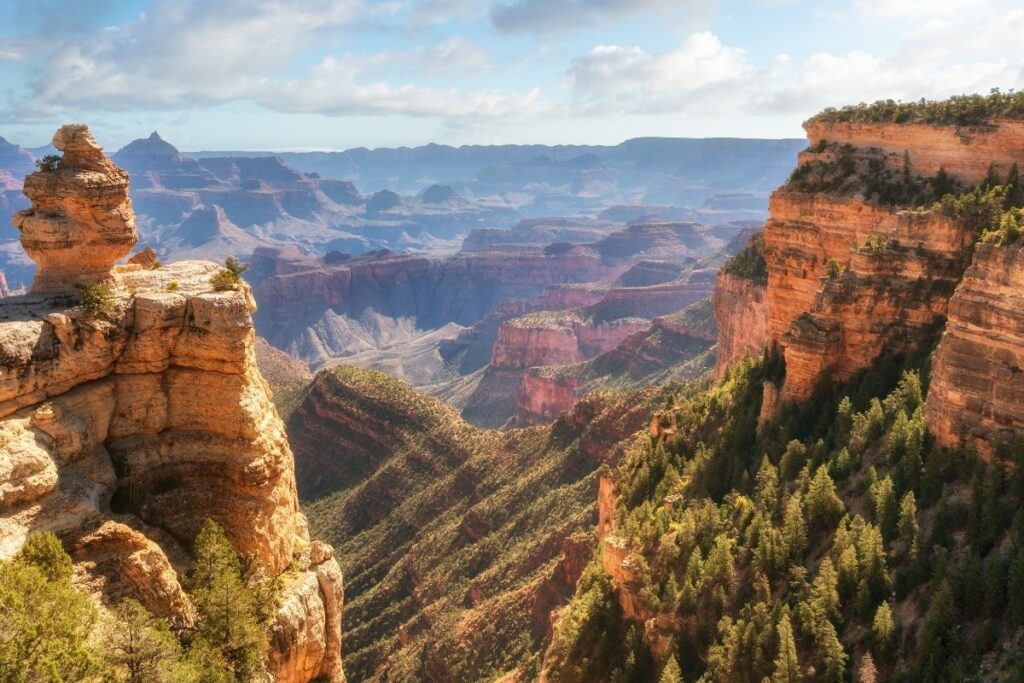
Visiting Grand Canyon National Park: The Complete Guide for 2024
- Jennifer Melroy
- Last Modified January 23, 2024
- First Published on September 9, 2021
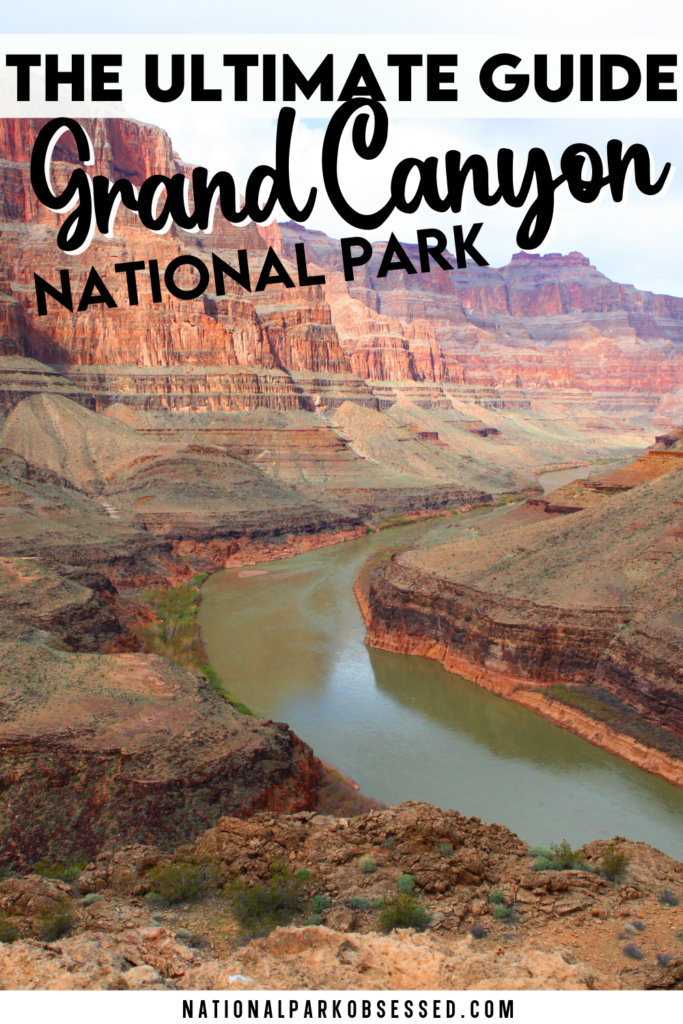
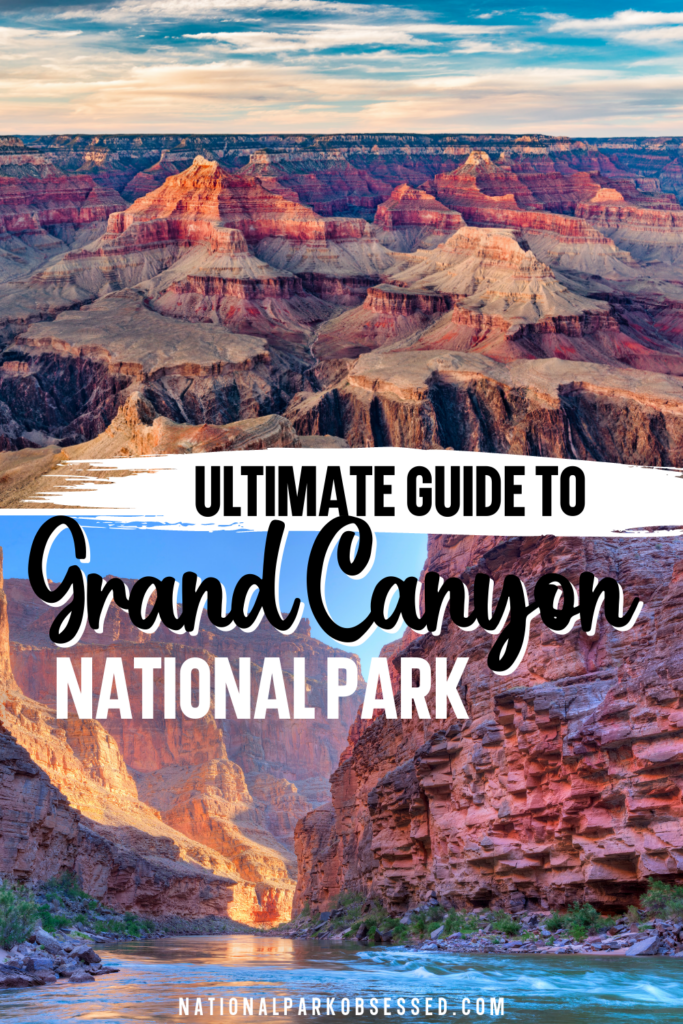
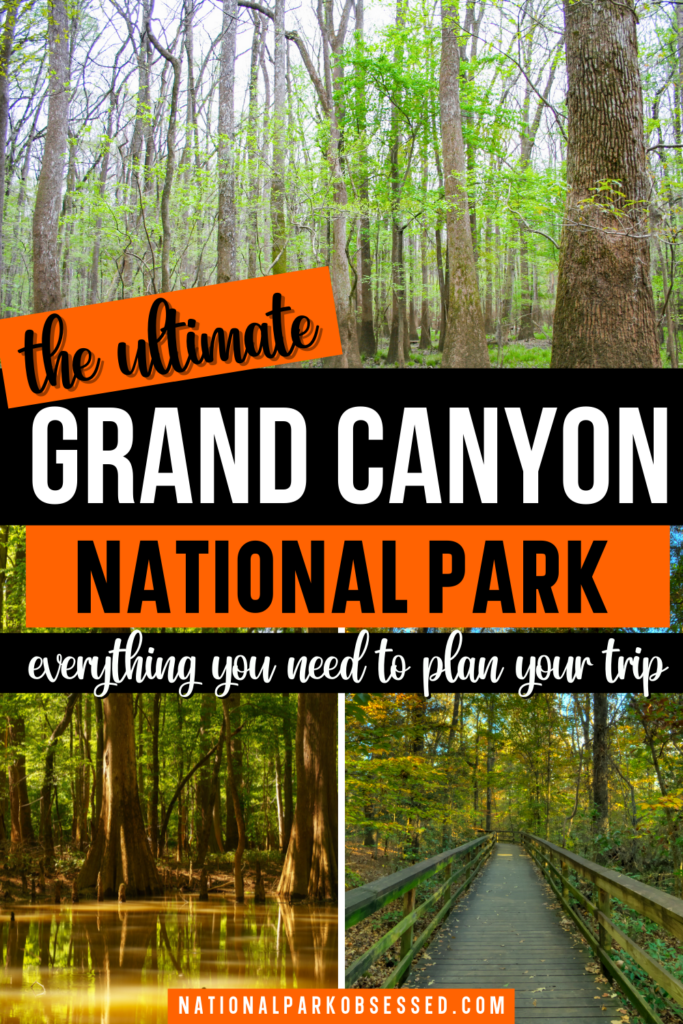
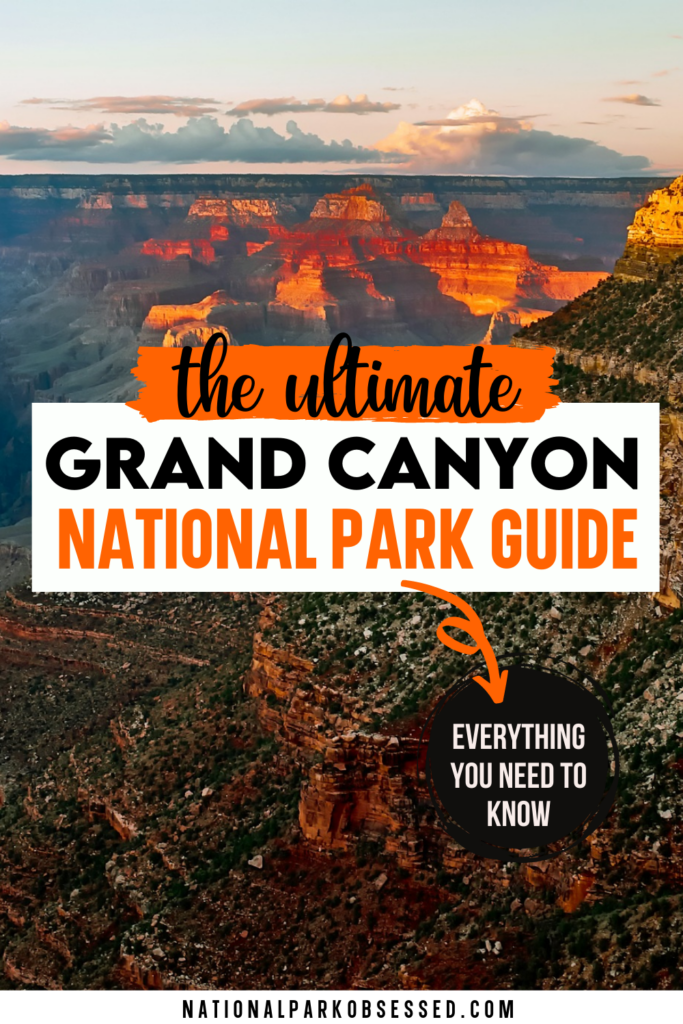
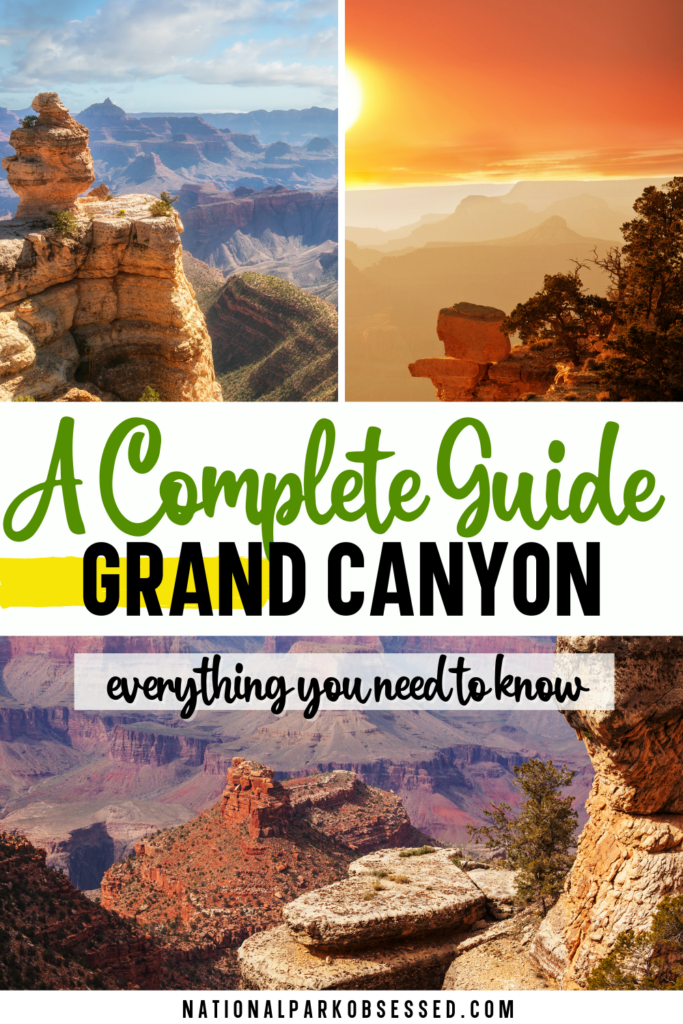
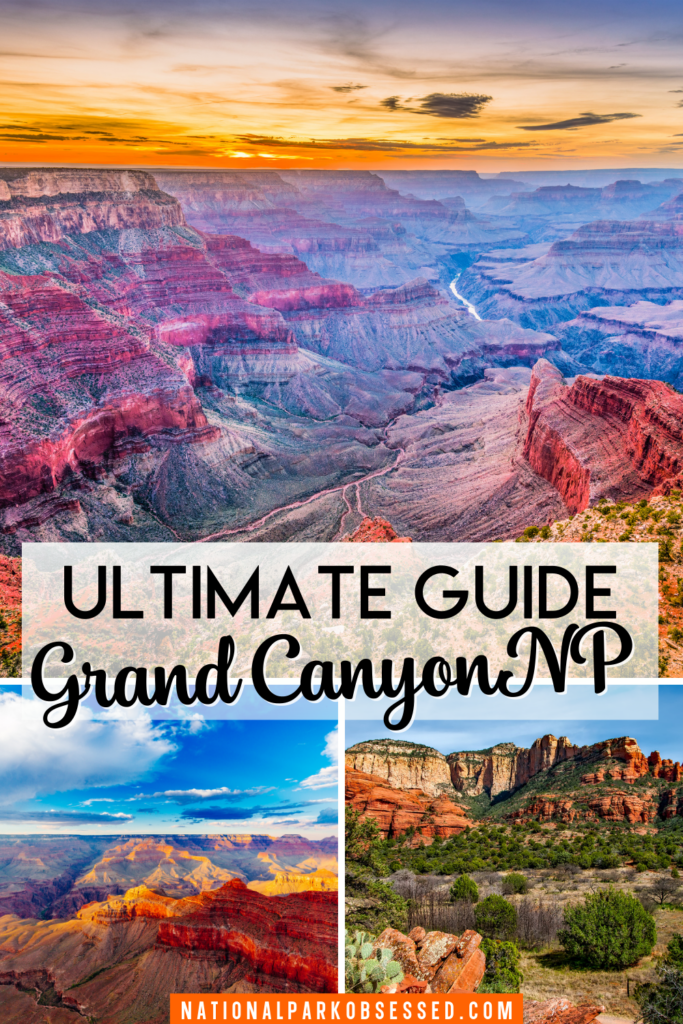

Post Summary: Visiting Grand Canyon National Park
Wonder of the Natural World, UNESCO World Heritage Site, International Dark Sky Park. The Grand Canyon holds a lot of titles in addition to being a US National Park. There is a reason that the Grand Canyon gets so much recognition. It’s an impressive canyon that stands sounds out among the canyon of the world. The Grand Canyon is 277 miles long and on average 10 miles across. Carved over millions of years by the Colorado River, this impressive canyon is one of Mother Natures’ finest works of art.
Visiting Grand Canyon National Park should be on your bucket list no matter what. As one of the most popular national parks, planning ahead is an important part of planning a trip to Grand Canyon. In this guide, we will be exploring Grand Canyon National Park and providing helpful hints and tips for planning a trip to Grand Canyon. We will help you avoid the crowds as well as find the best Grand Canyon hikes, and where to stay.
Best of Grand Canyon National Park in a Nutshell
CAN’T MISS: Things You Can’t Miss in the Grand Canyon
HIKES: Best Grand Canyon Hikes
ONE DAY: One Day in the South Rim
CAMPING: Camping in Grand Canyon National Park
NEARBY PARKS: Bryce Canyon, Petrified Forest, Zion
- The Quick Guide to Visiting Grand Canyon National Park
- Fun Facts about Grand Canyon National Park
- Where to stamp your National Parks Passport Book in XXX National Park?
- Recommend Reading for Grand Canyon National Park
- Grand Canyon National Park Gift Ideas
- National Park Obsessed’s Detailed Guides to Grand Canyon National Park
- Frequently Asked Questions about Grand Canyon National Park
- National Parks Near Grand Canyon National Park
- Final Thoughts on Visiting Grand Canyon National Park
- Pin for Later: Visiting Grand Canyon National Park: The Complete Guide (2021 Update)

This post may contain affiliate links, meaning if you book or buy something through one of these links, I may earn a small commission at no extra cost to you! Read the full disclosure policy here

The Quick Guide to Visiting Grand Canyon National Park
Map of Grand Canyon National Park
Click on the Grand Canyon Map above to download the official brochure map. If you’d like a PDF copy of this Grand Canyon Map click here.
Grand Canyon National Park Basics
Region: Intermountain / Southwest / West Coast
Park Size: 52,485.17 acres (82.00 sq miles) (212.40 sq km)
Location: Conconino and Mohave counties
Closest Cities: Fredonia and Tusayan, Arizona
Busy Season: March to October
Visitation: 5,974,411 (in 2019)
Funniest 1-Star Review: “It’s a giant ditch. When do we find out that it’s truthfully an old time excavation project from thousands of years ago?”
Official Website: NPS.gov
How much does Grand Canyon National Park Cost?
Grand Canyon National Park costs the following:
- 7-day Passenger Vehicle Pass – $35
- 7-day Motorcycle Pass – $30
- 7-day Individual Pass – $20
An annual Grand Canyon National Park Pass costs $70 but it is not recommended you buy this pass. For an extra $10 you can get an American the Beautiful Pass. This $80 pass offers free admission to all 116 fee-charging National Park Units.
When is Grand Canyon National Park Open?
Grand Canyon National Park is open year-round. The South Rim is open year-round. The North Rim is typically open to vehicle traffic from mid-May to mid-October.
Are dogs allowed in Grand Canyon National Park?
Yes, Grand Canyon is one of the most dog-friendly National Parks. Dogs are welcome on trails above the rim. Please review the Grand Canyon Pet Policy before bringing your dog to Grand Canyon.
Where are Grand Canyon National Park’s visitor centers?
Grand Canyon Visitor Center – Open Year Round
North Rim Visitor Center – Spring to Fall
Land Acknowledgments for Grand Canyon National Park
The National Park known as Grand Canyon National Park sits on Southern Paiute, Hopi, Havasupai, and Pueblos land.
Thank you to the Native Land Digital for making the Indigenous territories accessible to all. They have mapped the known territories to the best of their current knowledge and is a work in progress. If you have additional information on the Indigenous nations boundaries, please let them know.
Native Land Digital is a registered Canadian not-for-profit organization with the goal to creates spaces where non-Indigenous people can be invited and challenged to learn more about the lands they inhabit, the history of those lands, and how to actively be part of a better future going forward together.
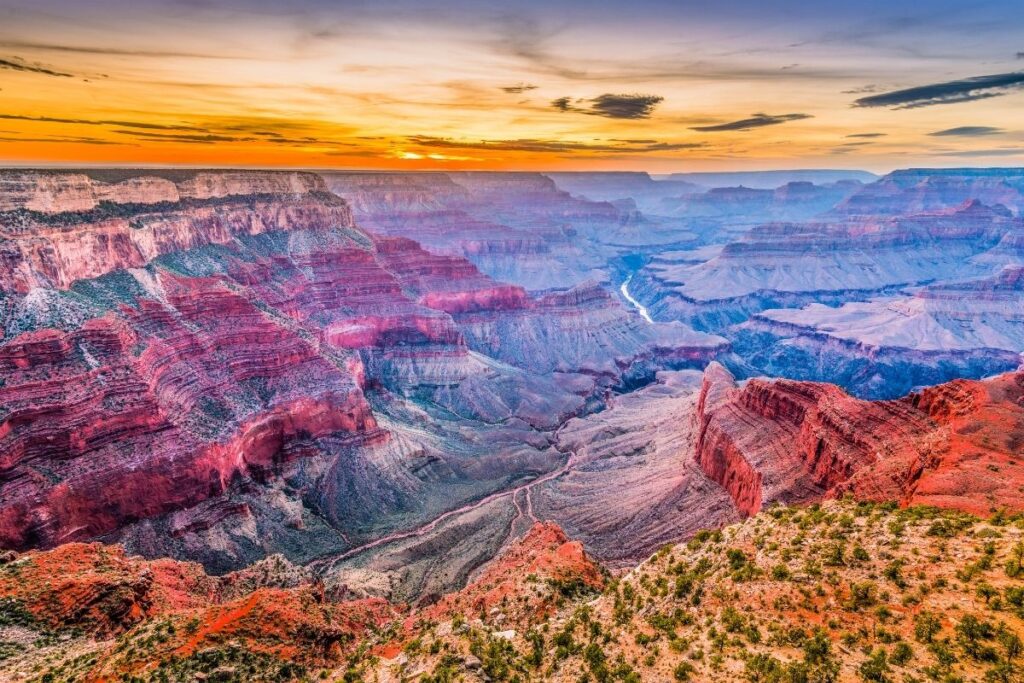
When was Grand Canyon National Park Created?
Grand Canyon National Park has a long human history. There is evidence of human activity that dates back at least 12,000 years. Around 4,000 years ago, the Ancestral Puebloan people moved into the region and became less nomadic. Over time, distinct cultures developed in different regions of the canyon.
The first Europeans to reach the Grand Canyon were Spanish soldiers in September 1540. They did some minor exploration in the canyon and moved on. There was minimal other European exploration until 1826 when American trappers arrived. After that, more Americans arrived and the development of the canyon started with crossings such as Lee’s Ferry.
The 1875 U.S. War Department’s expedition arrived looking for resources and the expedition geologist was impressed and pressed for an additional expedition to explore the river and area. The art and photos produced by these expeditions feed into the conservation movement and in 1887 then-Senator Benjamin Harrison introduced a bill to make Grand Canyon a National Park. His early efforts fail but once Harrison was elected U.S. President, he declared Grand Canyon a National Forest Preserve. Being a Forest Preserve didn’t provide a lot of protection from mining or logging but it was a start.
President Theodore Roosevelt visited the canyon in 1903 and used his powers under the Antiquities Act to declare the Grand Canyon a National Monument. It would take a further 11 years to get National Park status but on February 26, 1919, President Woodrow Wilson created Grand Canyon National Park.
Grand Canyon National Park preserves and protects the natural and cultural resources and ecological and physical processes of the Grand Canyon along with its scenic, aesthetic, and scientific values for the benefit and enjoyment of the public.
Grand Canyon National Park Foundation Document
Fun Facts about Grand Canyon National Park
- The highest point in Grand Canyon National Park is Point Imperial which is 8,803 feet (2,683 m) above sea level.
- The lowest point in Grand Canyon National Park is Lake Mead which is 1,173 feet (358 m) above sea level.
- Grand Canyon by the numbers
- 106 miles of paved roads
- 148 miles of unpaved roads
- 595 miles of hiking trails
- 3,391 ancestral sites
- Grand Canyon Wildlife
- 1,443 species of invertervrates
- 450 species of bird
- 91 species of mammal
- 58 species of reptiles and amphibians
- 18 species of fish (5 native)
- Grand Canyon is home to 5 endangered species
- California condor
- Humpback chub
- Razorback sucker
- Southwestern willow flycatcher
- Ridgway’s rail
- There are 9 endemic animals in the park including 5 butterflies, 1 pseudoscorpion, 1 tarantula, 1 snake, and 1 mollusk.
When to Visit Grand Canyon National Park
Grand Canyon National Park Visitation
Grand Canyon is busiest from March to October.
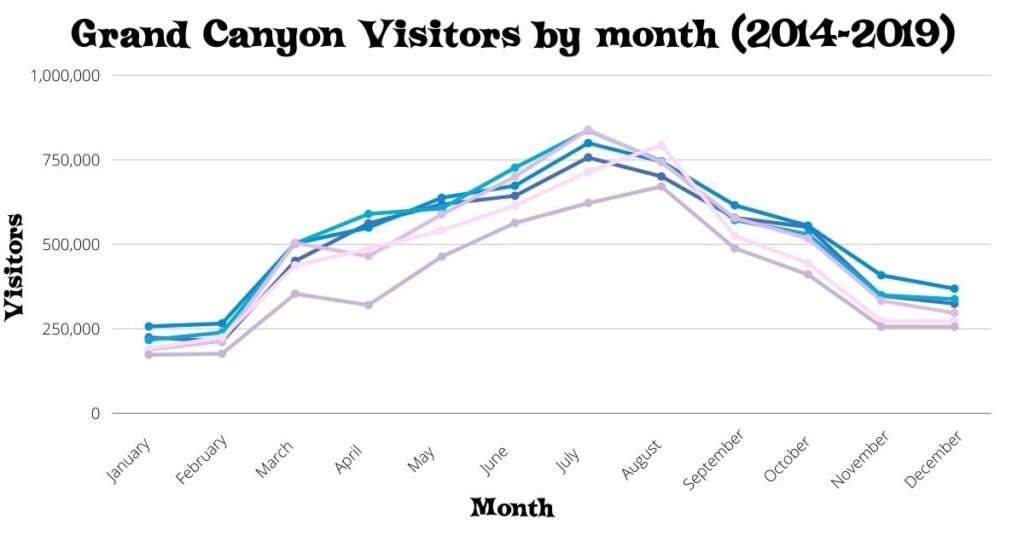
Zion National Park Weather
Grand Canyon National Park’s climate varies greatly depending on elevation and the canyon is so large that its valleys and ridges influence the weather. The park can be roughly divided into three main regions – South Rim, North Rim, and Inner Canyon. The North Rim has the highest elevations and is the coolest and wettest part of the park. The South Rim is generally warmer and drier than the North Rim. A general rule with the inner canyon is that with every 1000 ft in elevation loss the temperature rises by 5 degrees.
Plan your hikes carefully. Try to avoid hiking during the heat of the day. All hikers should carry lots of water and be prepared for changing conditions.
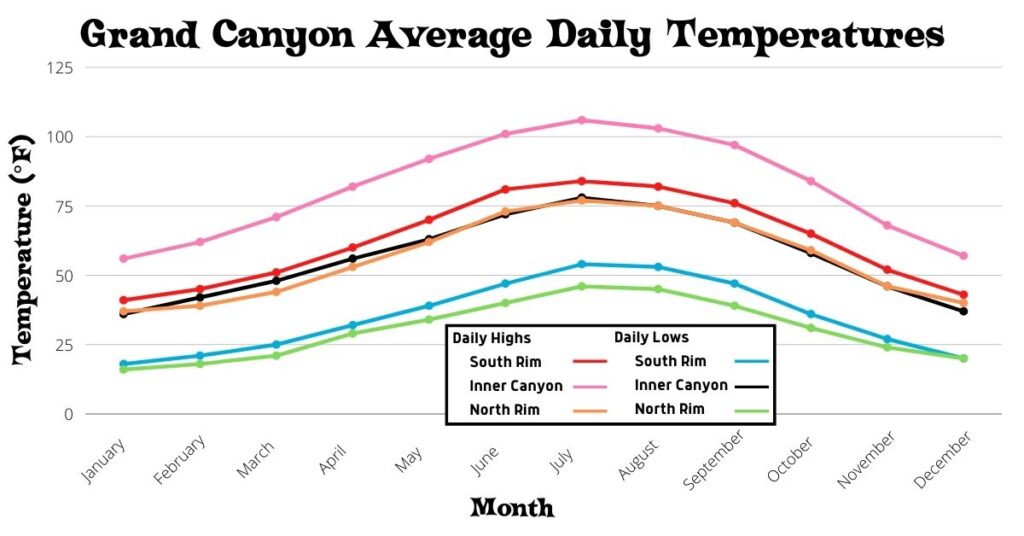
Where to stamp your National Parks Passport Book in Grand Canyon National Park?
The National Park Passport Book is the BEST and cheapest National Park souvenir. Every National Park Obsessed person should have one of these books.
If you are new to the National Parks, you can learn more about the National Parks Passport program here or jump right in by ordering:
- The ever-popular Classic National Parks Passport
- Get 15% Off Your Next Order at the America’s National Parks Online Store with Code: NATIONALPARKOBSESSED at Checkout
- Or get the National Park Obsessed’s National Park Passport & Journal
IMPORTANT: Do NOT stamp your government-issued passport.
There are 15 official Stamps for Grand Canyon National Park. Here is the list of National Park Passport Stamps you can get in Grand Canyon National Park:
- Cottonwood, AZ
- Desert View
- Desert View Watchtower
- Grand Canyon
- Grand Canyon, AZ
- Havasupai Gardens, AZ
- Indian Garden (National Park)
- Indian Garden (NP)
- Kolb Studio
- North Rim, AZ
- Phantom Ranch
- Tusayan Ruin
- Tuweep, AZ
- Verkamp’s
- Yavapai Geology Museum
Bonus Stamps
- Bright Angel
- Bright Angel History Room
- Canyon View Information Plaza
- Centennial
- Desert View Bookstore
- Discover Archaeology
- El Tovar
- El Tovar Grand Canyon National Park
- Hermits Rest
- Hermit’s Rest
- Historic Kolb Studio
- Historic Route 66
- Historic Route 66 Williams, Az
- Hopi House
- Lookout Studio
- Mailed By Mule At The Bottom Of The Grand Canyon Phantom Ranch
- Maswik
- North Rim
- Scorpion
- Tusayan Museum
- Verkamp’s Visitor Center
- Yavapai Observation Station
Grand Canyon National Park Passport Stamp Locations
Here are all the locations to find the Grand Canyon National Park Passport Stamps. Not every stamp is available at every location.
- Backcountry Information Center
- Bright Angel Lodge (BONUS ONLY)
- City of Williams Visitor Information Center Kaibab National Forest
- Cottonwood Campground
- Desert View Ranger Station
- Desert View Watchtower
- El Tovar Hotel (BONUS ONLY)
- Grand Canyon Conservancy Park Store
- Havasupai Gardens Visitor Information Station
- Hermits Rest Gift Shop (BONUS ONLY)
- Hopi House Gift Shop (BONUS ONLY)
- Kolb Studio Bookstore
- Lees Ferry Law Enforcement Office
- Lookout Studio Gift Shop (BONUS ONLY)
- Maswik Lodge Gift Shop (BONUS ONLY)
- North Rim Backcountry Information Center
- North Rim Ranger Roost
- North Rim Visitor Center
- Phantom Ranch Canteen
- Phantom Ranch Ranger Station
- Pipe Spring NM Visitor Center
- Roving Junior Ranger Table
- South Rim Visitor Center
- Tusayan Ruin Museum
- Tuweep Ranger Station
- Verkamp’s Visitor Center
- Yavapai Observation Station Bookstore
Recommend Reading for Grand Canyon National Park
Stories from Grand Canyon National Park
Non-Fiction Grand Canyon Books
- MUST READ – I Am the Grand Canyon: The Story of the Havasupai People – This is the story of the Havasupai people and their history living in the Grand Canyon and their fight to regain access to their homeland. Author Stephen Hirst was asked by the Havasupai to research and document their landmark legal case while living in the canyon.
- Over The Edge: Death in Grand Canyon – This is the definitive account of deaths in the Grand Canyon. Ghiglieri covers every recorded death in the canyon and tells their story.
- The Promise of the Grand Canyon: John Wesley Powell’s Perilous Journey and His Vision for the American West – A timely, thrilling account of the explorer who dared to lead the first successful expedition down the Colorado through the Grand Canyon—and waged a bitterly-contested campaign for sustainability in the West.
- The Grand Canyon: Unseen Beauty: Running the Colorado River – This is an amazing coffee table book that features images from the Grand Canyon and the Colorado River.
- The Grand Canyon: Between River and Rim – This coffee table book features award-winning photographer Pete McBride and shares the story of a gripping adventure of hiking all 750 miles of hiking trails in Grand Canyon National Park.
Fiction Grand Canyon Books
- Canyon Sacrifice – Archaeologist Chuck Bender is facing every person’s worst nightmare in Grand Canyon National Park. Murderous kidnappers have his child, and he must explore the cultural and rugged landscape of the Grand Canyon to save his child. This is the first book in Scott Graham’s National Park Mystery Series.
Grand Canyon Kid Book
- Grand Canyon by Jason Chin – This outstanding Grand Canyon children’s book is a must-read for any parent visiting the Grand Canyon with their children. This picture book packs the geologic history of the canyon into a magical story of a father-daughter hike.
- Brighty of the Grand Canyon – Brighty is a burro living in the Grand Canyon, and this is his story as an independent contractor working in the Grand Canyon. Based on a real burro who is said to have met President Theodore Roosevelt.
Best Grand Canyon National Park Guide Books
Grand Canyon National Park Gift Ideas
National Park Obsessed’s Detailed Guides to Grand Canyon National Park
Grand Canyon National Park Lodging
Itineraries for Grand Canyon National Park
Grand Canyon National Park Activity Guides
Grand Canyon Wildlife Viewing Guides
Other Articles featuring Grand Canyon National Park
Frequently Asked Questions about Grand Canyon National Park
How long does it take to tour Grand Canyon National Park?
You can spend as much time as you’d like and/or the amount of time you have. There is no right or wrong answer to as how much time to spend in the Grand Canyon. I’d recommend spending between one and three days at the Grand Canyon. With only one day, you have plenty of time to explore either the North or the South Rim and explore a few viewpoints, do a little hiking and get a feel for the park. The most important thing is to make the most of your time in the Grand Canyon.
Does Grand Canyon require reservation?
As of September 2021, you do not NEED a reservation to enter the Grand Canyon. If you are planning at staying at one of the lodges or camping at the Grand Canyon, you should try to make a reservation.
Can you drink the water in the Grand Canyon?
There is potable water available in the developed areas of the park and along select trails. Some of these portable water sources are seasonal and many are shut off during winter or during the summer due to repairs or low water levels. Please confirm with NPS that the water source is available before planning to refill there.
- Bright Angel Campground
- Bright Angel Trail, Mile-and-a-Half Resthouse
- Bright Angel Trail, Three-Mile Resthouse
- Bright Angel Trailhead
- Bright Angel Trailhead
- Canyon Village and Desert View Marketplaces
- Cottonwood Campground
- Desert View Visitor Center
- Grand Canyon Visitor Center
- Hermits Rest
- Indian Garden
- Manzanita Day Use Area
- Maswik Lodge (in the cafeteria)
- North Kaibab Trailhead
- North Kaibab Trailhead,
- North Rim Backcountry Office.
- North Rim Visitor Center (adjacent to the restrooms)
- Phantom Ranch
- Plateau Point
- Roaring Springs Day Use Area
- South Kaibab Trailhead
- South Kaibab Trailhead
- Supai Tunnel
- Verkamp’s Visitor Center
- Yavapai Geology Museum
All water sources outside of these water bottle filling stations or potable water spigots must be treated and disinfected. Make sure the silt particles have settled to the bottom and then filter the clear water with at least a 1-micron water filter. After filtering the water, treat it with iodine or household bleach and let sit for 30 minutes or longer or boil the water for 1 minute (or more pending elevation).
Is the Grand Canyon one of the 7 Wonders of the World?
The Grand Canyon is often considered to be one of the Seven Natural Wonders of the World. Over the years, various organizations have complied their list of Seven Natural Wonders of the World. The Grand Canyon has made many of these lists including the 1997 CNN list.
In November 2006, USA Today and Good Morning American revealed their list of New Seven Wonders based on viewer feedback, the Grand Canyon was added as the viewer-chosen Eighth Wonder of the World.
What is the best time to visit the Grand Canyon?
The best time to visit Grand Canyon National Park is March through May and September through November. Visiting in the Spring and Fall is my favorite because the temperatures are cooler and the crowds are thinner.
Which rim of the Grand Canyon is best?
It depends. Most of the classic views and most of the park amenities are located on the South Rim and its open year-round. Personally, I prefer the North Rim. It’s a bit cooler for hiking and less crowded.
What is the most beautiful part of the Grand Canyon?
There is no bad view when standing on the edge of the Grand Canyon looking across. My favorite viewpoint is Desert View. I love how you can see just a bit of the view and get a visual for how big and grand the Grand Canyon is.
What should you not miss at the Grand Canyon?
You shouldn’t miss the sunrises, sunsets, and star gazing opportunities at the Grand Canyon. It doesn’t matter which Rim of the Grand Canyon you visit these sights are some of the prettiest anywhere in the world.
How far is Las Vegas from Grand Canyon?
Grand Canyon National Park is about 160 miles from Las Vegas as the crow flies. It’s a 4 and a half-hour drive from Las Vegas to the North or the South Rim of the Grand Canyon. Grand Canyon West is NOT part of Grand Canyon National Park but Grand Canyon West is a two and a quarter-hour drive from Las Vegas.
How close is Sedona to Grand Canyon?
It is a 120 mile and two and a quarter-hour drive from Sedona to Grand Canyon National Park’s South Rim. The North Rim is a four and quarter-hour drive from Sedona.
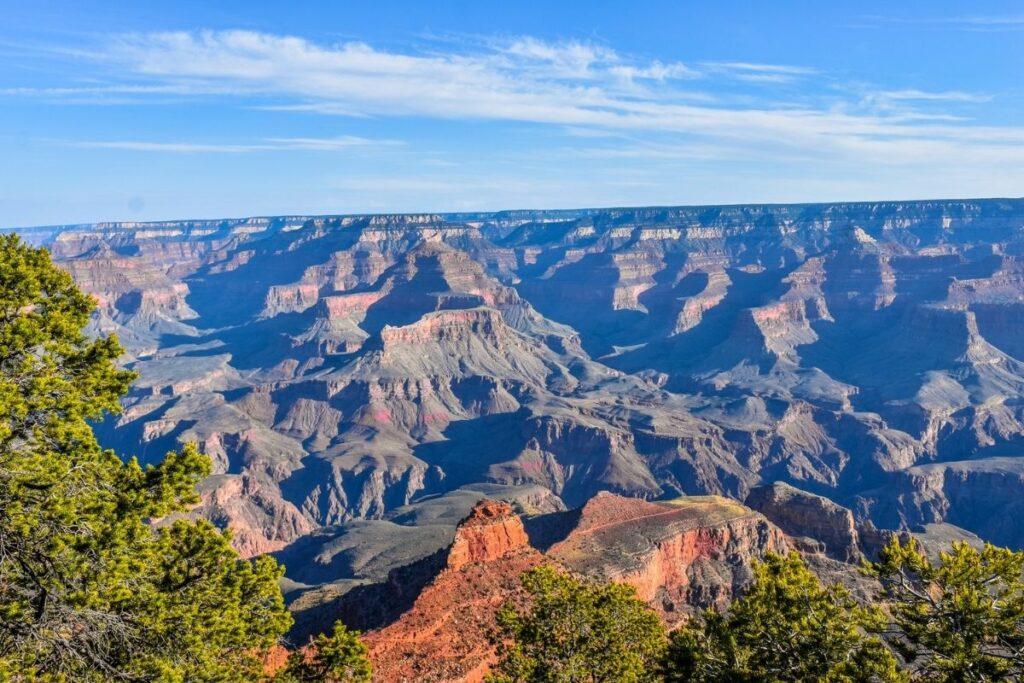
National Parks Near Grand Canyon National Park
Check out this great 63 National Parks and get a FREE National Park Checklist. Count how many National Parks you have visited.
National Park Service units within a 4 hours drive
- Wupatki National Monument – 50 mintues
- Sunset Crater Volcano National Monument – 1.17 hours
- Pipe Spring National Monument – 1.33 hours
- Walnut Canyon National Monument – 1.5 hours
- Glen Canyon National Recreation Area – 1.5 hours
- Rainbow Bridge National Monument – 1.5 hours
- Montezuma Castle National Monument – 2 hours
- Navajo National Monument – 2 hours
- Zion National Park – 2.33 hours
- Tuzigoot National Monument – 2.5 hours
- Cedar Breaks National Monument – 2.5 hours
- Bryce Canyon National Park – 2.67 hours
- Petrified Forest National Park – 2.83 hours
- Hubbell Trading Post National Historic Site – 3 hours
- Canyon De Chelly National Monument – 3.25 hours
- Lake Mead National Recreation Area – 3.25 hours
- Yucca House National Monument – 3.83 hours
- Hovenweep National Monument – 3.83 hours
- Hohokam Pima National Monument – 4 hours
- Tonto National Monument – 4 hours
- Mesa Verde National Park – 4 hours
- Mojave National Preserve
National Park Service units within an 8 hours drive
- Castle Mountains National Monument – 4.17 hours
- Natural Bridges National Monument – 4.25 hours
- Aztec Ruins National Monument – 4.5 hours
- Captiol Reef National Park – 4.5 hours
- Casa Grande Ruins National Monument – 4.5 hours
- Arches National Park – 5 hours
- Canyonlands National Park – 5 hours
- Great Basin National Park – 5 hours
- Saguaro National Park – 5 hours
- Organ Pipe Cactus National Monument – 5.17 hours
- El Morro National Monument – 5.83 hours
- El Malpais National Monument – 5 hours
- Chaco Culture National Historical Park – 5.5 hours
- Joshua Tree National Park – 5.5 hours
- Timpanogos Cave National Monument – 5.75 hours
- Tumacacori National Historical Park – 5.75 hours
- Death Valley National Park – 5.75 hours
- Petroglyph National Monument – 6.25 hours
- Black Canyon of the Gunnison National Park – 6.83 hours
- Valles Caldera National Preserve – 7 hours
- Chiricahua National Monument – 7 hours
- Fort Bowie National Historic Site – 7 hours
- César E. Chávez National Monument – 7 hours
- Bandelier National Monument – 7.33 hours
- Golden Spike National Historical Park – 7.5 hours
- Pecos National Historical Park – 7.67 hours
- Curecanti National Recreation Area – 7.75 hours
- Manhattan Project National Historical Park – Los Alamos Unit – 8 hours
- Salinas Pueblo Missions National Monument – 8 hours
- Great Sand Dunes National Park and Preserve – 8 hours
- Dinasour National Monument – 8 hours
Final Thoughts on Visiting Grand Canyon National Park
Do you have any questions about Grand Canyon National Park or need help planning your National Park trips. Let me know in the comments or join me in my National Park Trip Planning Community!
Pin for Later: Visiting Grand Canyon National Park: The Complete Guide (2021 Update)

Jennifer Melroy
Hi, I'm Jennifer!
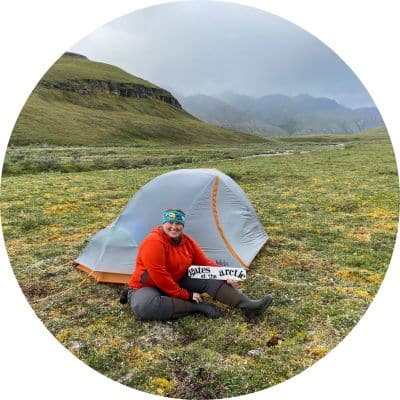
Welcome to the wonderful world of National Parks. I'm here to help you plan your NEXT amazing adventure through the United States National Parks and beyond. I want the national parks to be accessible to all.
I live in Tennessee, and when I'm home, you can find me hiking in the Smokies and the Cumberland Plateau.
58/63 National Parks
250+/423 National Park Units
Want to know more? Start Here.
Explore More
ACKNOWLEDGEMENT OF LAND
On this site, we promote travel to the United States and beyond that are the traditional lands of Indigenous and First Nations peoples.
With respect, I make a formal land acknowledgment, extending my appreciation and respect to these lands’ past and present people.
To learn more about the people who call these lands home, I invite you to explore Native Land.
DISCLAIMER
National Park Obsessed assumes no responsibility or liability for any errors or omissions in the content of this site (NationalParkObsessed.com). The information contained in this site is provided with no guarantees of completeness, accuracy, usefulness or timeliness. You are encouraged to conduct your own due diligence before acting on the information provided on this site and should not rely on the opinions expressed here.
There is an inherent risk in all outdoor recreation activities, the reader assumes all responsibility for their own personal safety.
DISCLOSURE
We are a participant in the Amazon Services LLC Associates Program, an affiliate program designed to provide a means for us to earn fees by linking to Amazon.com and affiliated sites.
Privacy Policy • About Us • Contact
Select stock photography provided depositphotos
Copyright ©2023 National Park Obsessed, LLC
Privacy Overview
Last Updated on 23 Jan 2024 by Jennifer Melroy
